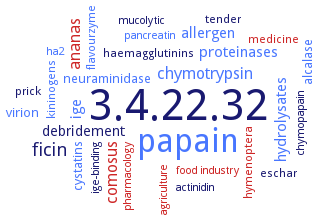3.4.22.32: Stem bromelain
This is an abbreviated version!
For detailed information about Stem bromelain, go to the full flat file.

Word Map on EC 3.4.22.32 
-
3.4.22.32
-
papain
-
ficin
-
comosus
-
chymotrypsin
-
ananas
-
hydrolysates
-
allergen
-
proteinases
-
ige
-
debridement
-
neuraminidase
-
alcalase
-
cystatins
-
virion
-
hymenoptera
-
flavourzyme
-
medicine
-
kininogens
-
prick
-
eschar
-
tender
-
haemagglutinins
-
food industry
-
actinidin
-
ha2
-
agriculture
-
chymopapain
-
mucolytic
-
pharmacology
-
pancreatin
-
ige-binding
- 3.4.22.32
- papain
- ficin
- comosus
- chymotrypsin
- ananas
- hydrolysates
- allergen
- proteinases
- ige
-
debridement
- neuraminidase
- alcalase
- cystatins
- virion
- hymenoptera
- flavourzyme
- medicine
- kininogens
-
prick
-
eschar
-
tender
-
haemagglutinins
- food industry
- actinidin
- ha2
- agriculture
- chymopapain
-
mucolytic
- pharmacology
- pancreatin
-
ige-binding
Reaction
broad specificity for cleavage of proteins, but strong preference for Z-Arg-Arg-/-NHMec amongst small molecule substrates =
Synonyms
acidic bromelain stem proteinase, ACMD2_17643, BRM, Bromelain, Bromelain, stem, EC 3.4.22.4, EC 3.4.4.24, Pineapple stem bromelain, SBA, Sbm, stem bromelain
ECTree
Advanced search results
General Stability
General Stability on EC 3.4.22.32 - Stem bromelain
Please wait a moment until all data is loaded. This message will disappear when all data is loaded.
bromelain immobilized to IDA-Sepharose 6B matrix loaded with Cu2+, Ni2+ and Zn2+ is more resistant to thermal inactivation, as evidenced by retention of over 50% activity after incubation at 60°C
-
denaturation in guanidine hydrochloride, the deglycosylated enzyme is more sensitive than the glycosylated one, midpoints of transition are at 2.28 M and 2.86 M, respectively
-
dextran (D70) and polyethylene glycol (P12 and P20) destablize native bromelain structure
enzymatic activity of bromelain remains uninfluenced by the immobilization of heparin on it
-
enzyme affinity-bound to a Sepharose matrix precoupled with the lactin concanavalin A is more stable to thermal inactivation than native enzyme or enzyme covalently coupled to the CNBr-activated Sepharose
-
glutaraldehyde-crosslinked bromelain has comparable activity to the native enzyme, is more stable against urea, guanidine hydrochloride and temperature-induced inactivation and exhibit better storage ability compared to the unmodified protease
-
glycerol and sorbitol are acting as stabilizers at all concentrations while sucrose and trehalose are destabilizers at lower concentrations, however, act as stabilizers at higher concentrations. Urea and guanidine hydrochloride are denaturants except at lower concentrations
-
immobilization on amino-Sepharose leads to higher proteolytic activity and remarkably enhanced thermal stability as compared to soluble bromelain and that coupled to CNBr- activated Sepharose
immobilized bromelain shows a higher half-life respect to the free enzyme. The addition of free cysteine during immobilization phase, improves bromelain half-life more than 4folds
-
increase in ionic strength by addition of salts results in folded structures somewhat different from the native enzyme. Salt-induced intermediates are characterized by increase in helical content and a significantly reduced exposure of hydrophobic clusters relative to the state at pH 2.0. Salt-induced state shows non-cooperative thermal denaturation alcohol-induced intermediates of the enzyme exhibit increased helical content. Alcohol-induced state shows a cooperative thermal transition
-
poly(ethylene glycol)-400-induced state has characteristics of molten globule, higher molecular weight poly(ethylene glycol)s cause unfolding of the acid unfolded state
-
Stem bromelain covalently coupled to a thermosensitive polymer of N-isopropylacrylamide either through the amino groups of the enzyme (randomly coupled) or via the lone oligosaccharide chain (uniformly coupled) shows better thermostability. The enzyme coupled via the oligosaccharide chain exhibits better access to the substrate casein as compared to the preparation in which the amino groups formed the point of contact between the enzyme and the polymer.
-
the imidazolium-based ionic liquids, 1-butyl-3-methylimidazolium chloride, 1-butyl-3-methylimidazolium bromide, and 1-butyl-3-methylimidazolium iodide, act as destabilizers on stem bromelain, analysis using UV-visible spectroscopy, steady-state and thermal fluorescence, circular dichroism spectroscopy and dynamic light scattering measurements, overview. The destabilization behaviour increases with increase in the chaotropicity or decrease in the kosmotropicity of the anion of the ionic liquid
the low bromelain activity, particularly in the upper portion of the murine gastrointestinal tract, following oral administration, suggests that extensive gastric inactivation of bromelain may occur in vivo. When formulated in antacid, oral bromelain retains substantial proteolytic activity throughout the gastrointestinal tract (of mice)
-
the pyromellitic anhydride- and poly(maleic anhydride)-modified bromelain does not lose its activity significantly
-
treatment with 10-30% (v/v) 1,1,1,3,3,3-hexafluoroisopropanol induces the partially folded intermediate to adopt much of the native proteins secondary structure, but only a rudimentary tertiary structure, characteristic of the molten globule state. Addition of slightly higher concentrations of 1,1,1,3,3,3-hexafluoroisopropanol causes transformation from an alpha-helix to a beta-sheet and induces formation of a compact nonnative structure
-


 results (
results ( results (
results ( top
top





